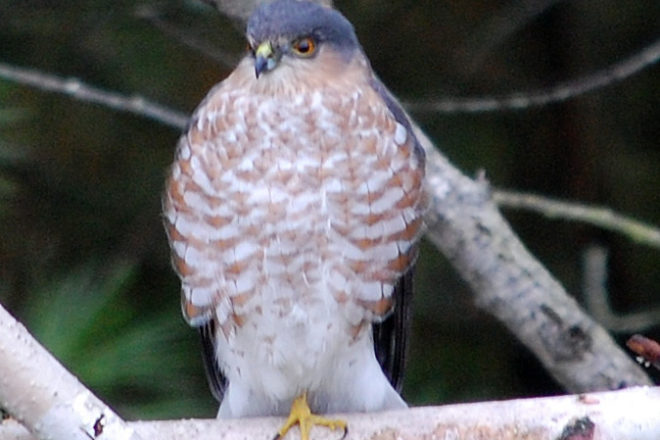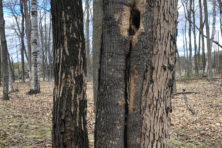When Hawks Become Pests
- Share
- Tweet
- Pin
- Share

by Rob Hults, Executive Director, Open Door Bird Sanctuary
Not all folks have the same level of appreciation for our resident raptors as many other nature lovers and I do. We’ve all heard the stories of treasured pets disappearing, surely the victims of ravenous raptors. Or the unflattering name “Chicken Hawk” given to our native Red-tailed Hawk.
Yes, some of these stories may be founded in bits of truth. but for the most part they are the tales of urban legend. Do unattended pets and poultry disappear? Sure they do. But busy roadways, feral dogs and cats, coyotes, foxes, weasels or simple wanderlust are the most likely reason that these domesticated critters don’t return home. And in honest defense of the Red-tailed Hawk, if I was on my way to lunch in town, and saw a country roadside stand offering free food, I’d likely shorten my trip and partake of the easy meal too.
There are two species of hawks whose reputation among backyard bird enthusiasts is less than stellar. In their case, it’s a reputation based on truth. They’re both predators of other birds and are both commonly seen in rural, suburban, and even urban settings.
I field a lot of calls here at the sanctuary about Door County birds, sometimes from an unhappy homeowner who has witnessed something they weren’t expecting to see out their living room window. A typical call from that homeowner will sound something like this:
“Rob, I’m a bird lover, and have many feeders in my yard. Lately there’s been a hawk coming in and snacking on my songbirds. What can I do to stop it?”
I have to admit, being a raptor fan, my first thought is, awesome! But I, too, am a lover of all birds, so I offer a solution, and some education, to the distressed caller. And we’ll get to that advice right after we identify those stealers of songbirds.
They are the Cooper’s Hawk (accipiter cooperii), and the Sharp-shinned Hawk (accipiter striatus). Due to their similar appearance and habits, they can be described together. The Coop and the Sharpie are both woodland hawks. Characterized by their smallish heads, short rounded wings and long banded tails they can be most difficult to differentiate in the field.
The Cooper’s Hawk is the larger of the two species, with an overall size just smaller than a common crow. The Sharp-shinned is very close in size to a Mourning Dove. Their sizes will vary within the species, with females considerably larger than the males. Both species have a slate gray back, and narrow rust-colored horizontal banding on their breasts in their adult plumage. First year juveniles are overall more rusty brown in color, with broken vertical brown streaking on their breast. Long featherless legs, long toes, and needlelike talons give them the ideal hunting tools for a mid-air capture of their next meal.
Whether perching or actively cruising on the wing in likely habitats for their smaller bird prey, a combination of surprise and a high energy aerial pursuit will generally reward these hawks with the satisfied feeling of a full stomach. Both species are opportunistic hunters, and will also capture small mammals if they are available.
Both species are casual to serious migrants, meaning their migration may take them just a couple hundred miles south, or as far south as the Gulf Coast and Mexico. Here in Door County their, summer and winter ranges do overlap, so both the Coop and the Sharpie can be seen here year round.
Now that we know who these marauders are, we’ll get back to that phone call.
First comes the solution to the “problem.” Predatory birds like the Cooper’s and Sharp-shinned hawks need to hunt and eat daily. And if they find a ready food source (your yard filled with songbirds), they will return until that food source diminishes. Take down and pack away your feeders for a week or so. Your songbirds will do just fine on their own, and the hawk will move on to greener pastures elsewhere. Once your feeders are back in place, your songbirds will generally return in a matter of hours. If the hawk comes back, repeat the process. Problem solved.
But is it really a problem? Here comes the eye-opening part. In the grand scheme of nature, having that hawk frequenting the habitat in your area is actually beneficial to the prey population. Maybe not to the individual bird that becomes a meal, but to the overall population, it surely is a benefit.
Hawks don’t go after the strongest prey they can find. They seek out the prey that will require the least amount of effort to capture. The old, slow, weak and injured birds are the ones they target.
Out of energy conservation and instinctual knowledge, they leave the strongest, smartest, and healthiest prey animals (again, your songbirds) to survive to the next breeding season. This insures the health and vitality of their food source for many generations to come. And insures that you, the feeder of songbirds, will enjoy the benefits of their selective harvest as well, by being given a vibrant healthy population of yard birds to watch and enjoy for many years to come.
So if you find yourself witnessing a bird of prey making off with one of “your” songbirds, keep an open mind. He’s doing his job and doing it well. Kudos to you for helping to create a healthy environmental niche that can support an apex predator like a Cooper’s Hawk or Sharp-shinned Hawk. Next time it happens, you get a gold star if you leave your feeders out.


